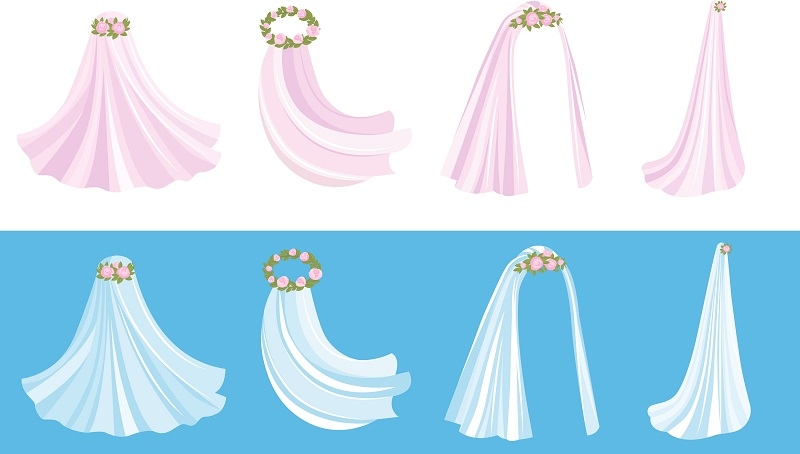
A wedding veil is one of the oldest bridal accessories, and it brings a touch of romance, elegance, and tradition to the wedding day attire. Although not all brides wear one, those that do will find that the perfect veil finishes off the look just right. With so many styles to choose from today, knowing what the various styles look like can be confusing. This is why wedding veil styles explained thoroughly enable brides to make educated decisions.
This guide takes you through the most popular choices, gives you some tips on selecting a bridal veil, and delves into the discussion of wedding veil vs no veil so you can determine what works best for you.
The wedding veil has been around for thousands of years. In some societies, it represented modesty and purity, and in others, protection from evil spirits. Veils eventually became indicative of tradition and formality in Christian weddings, and the veil being lifted was a symbol of the bride moving on to a new stage of life.
Today, the significance is much more individual. Some brides veil up out of respect for tradition, and others view veils as a stylish accessory that adds to their dress. With wedding veil fashion discussed, contemporary brides can blend tradition with individual style to achieve a sense that's uniquely their own.
While considering various bridal styles, it is useful to divide wedding veils according to length and style. Each of them is distinguished by a certain degree of formality and sophistication.
The short veil falls on part of the face and is manufactured from netting. It provides a vintage-looking effect that is elegant and playful. The style is preferred by brides who need the decorativeness of a retro touch.
The blusher is one layer of tulle draped across the face, traditionally raised during the ceremony. It gives a feeling of expectation and romance, and looks fantastic under both short and long veils.
This veil falls to the shoulders, is lightweight, and easy to handle. It looks great under gowns that have elaborate backs or decorations you would like to reveal.
Finishing at the elbows, this style provides symmetry for fuller-skirted dresses. It provides a classic but not overwhelming length.
Falling to the fingertips with arms relaxed, this is perhaps the most common style. It combines sensibility with sophistication and is appropriate for most dress styles.
Also referred to as ballet-length, this veil reaches from the knees to the ankles. With this option, you retain some mobile ability but keep a strikingly serious posture.
This option flows (or rather puddles) completely to the ground, right below the hem of the dress. It is formal and is frequently chosen for events taking place in a church or larger facility.
The cathedral veil is most dramatic, draping several feet down from the dress. It is best for brides who want a focal entrance and who play well in spacious areas.
This round veil with lace edge is worn draped across the head, forming a gentle border around the face. It has Spanish roots and is traditional and romantic.
Now that these kinds of wedding veils have been described, it becomes simpler to pair them with your dress and ceremony location.
Selecting the right veil is more than simply choosing the most beautiful one. It must go with your gown, bring out the best in your face, and not get hot or awkwardly positioned during the day. Consider these points:
A plain gown goes well with a more adorned veil, and a lavishly beaded dress may require something simpler. Balance is the key.
A cathedral veil works best in a grand setting, while a shorter veil is practical for outdoor weddings.
Some veils attach better to updos, while others drape more gracefully with loose curls.
You'll have that veil on for a while, so pick one that's comfy and easy to deal with.
Got a tiara, flower crown, or some bold earrings? Make sure your veil goes with them, not against them.
If you remember these suggestions, finding the right bridal veil should be easier and fun.

Not all brides desire a veil, and that is just fine. Wedding veil vs no veil is strictly a matter of personal style.
Either style is lovely in its own way. Some brides wear a veil for the wedding ceremony and take it off for the reception. At the end of the day, having different wedding veil styles described provides you with possibilities, but ultimately, comfort and confidence are paramount.
The veil must be an extension of your wedding gown. This is how various combinations will work:
If you observe wedding veil styles described in terms of dress shapes, then it is evident how much emphasis there is on proportion and balance.
Wedding fashion is constantly changing, and veils are no different. Some of the current trends are:
Such contemporary touches show that even when tradition is kept, today's brides can still infuse a personal touch.
Even if you have found the veil that is right for you, you need to ensure it stays in place and keeps a perfect look throughout the day.
With these little preparations, the veil becomes a worry-free aspect of your day.
A veil is not a mere accessory—it's an expression of your personality, style, and wedding vision. By having wedding veil styles defined, brides understand the numerous gorgeous options available, from the short birdcage to the show-stopping cathedral designs. Understanding the different types of wedding veils, how to select a bridal veil, and considering wedding veil vs no veil allows every bride to make a decision that truly represents her.
At the end of the day, no matter whether you walk down the aisle with a loose cathedral veil or without a veil, it's most important that you feel confident and radiant. Your wedding is for celebrating love, and the veil should only be an afterthought—if you decide to use one at all.
This content was created by AI